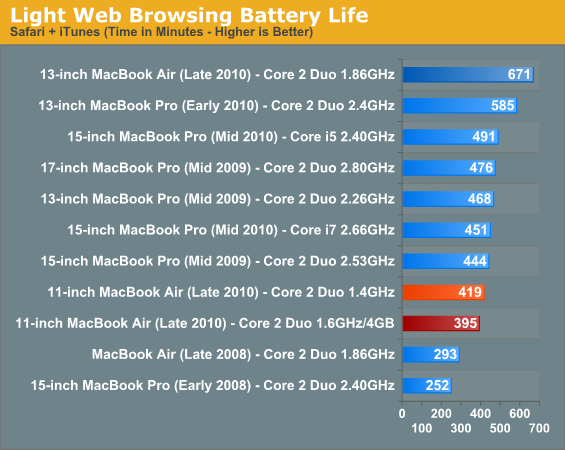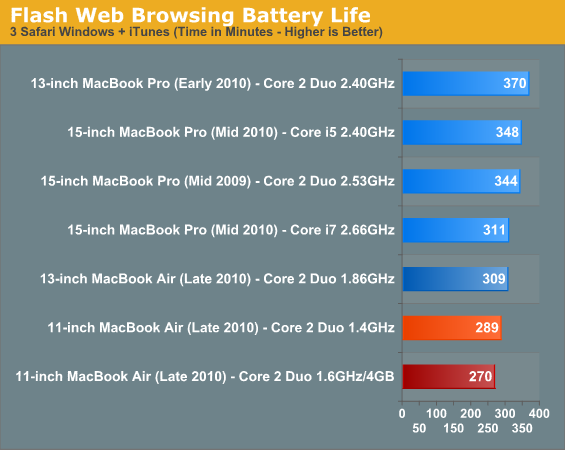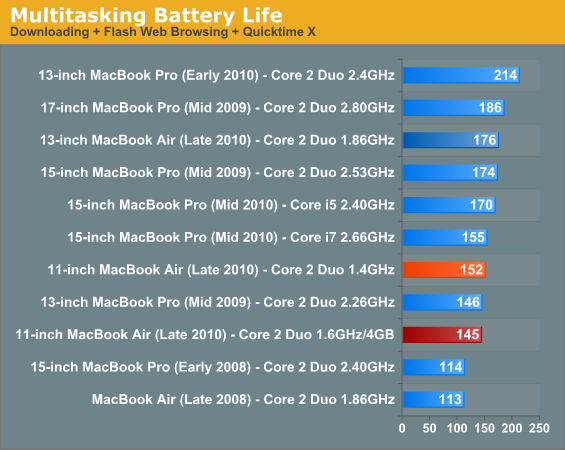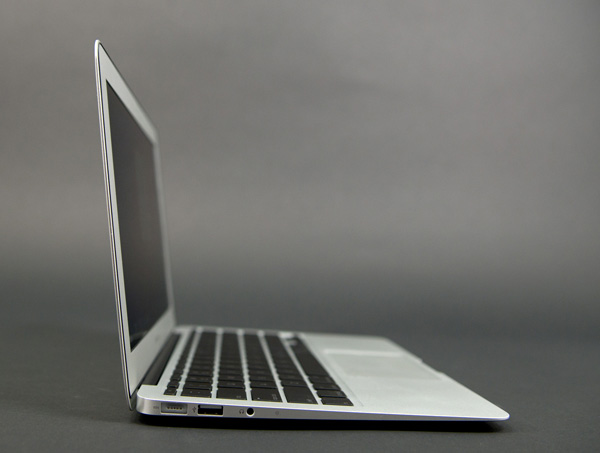Apple's 11-inch Upgraded MacBook Air: Do 1.6GHz and 4GB Make a Difference?
by Anand Lal Shimpi on November 6, 2010 2:35 AM EST- Posted in
- Mac
- Apple
- MacBook Air
- Laptops
Battery Life
Intel ships microprocessors, even those running at the same frequency, at varying voltages. Chips with lower leakage ship at lower voltages, while higher leakage chips ship at higher voltages. All CPUs have to ultimately fit within the same power envelope, but anything below that max TDP is fair game.
Running at a higher frequency generally requires a higher voltage, which in turn increases power consumption. I ran the upgraded 11-inch through all of our battery life tests to measure its impact.
Light Web Browsing
Here we're simply listing to MP3s in iTunes on repeat while browsing through a series of webpages with no flash on them. Each page forwards on to the next in the series after 20 seconds.
The display is kept at 50% brightness, all screen savers are disabled, but the hard drive/SSD is allowed to go to sleep if there's no disk activity. The wireless connection is enabled and connected to a local access point less than 20 feet away. This test represents the longest battery life you can achieve on the platform while doing minimal work. The results here are comparable to what you'd see typing a document in TextEdit or reading documents.

Flash Web Browsing
The test here has three Safari windows open, each browsing a set of web pages with between 1 - 4 animated flash ads per page, at the same time. Each page forwards onto the next after about 20 seconds.
As always, the display is set to 50% brightness, audio at two bars, screensaver disabled and the hard drive/SSD is allowed to go to sleep if idle. The wireless connection is enabled and connected to a local access point less than 20 feet away.

Multitasking Battery Life
Our final battery life test is the worst case scenario. In this test we have three open Safari windows, each browsing a set of web pages with between 1 - 4 flash ads per page, at the same time. We're also playing an XviD video in a window all while downloading files from a server at 500KB/s.

Overall the upgraded hardware resulted in a minimal impact to battery life. The worst impact was in the Flash web browsing test in which the upgraded system delivered 93% of the battery life of the base 11-inch MBA. The remaining two tests offered between 94 - 95%.
Given the 15% average improvement in performance when you need it, a 6% average reduction in battery life isn’t bad.











85 Comments
View All Comments
solipsism - Saturday, November 6, 2010 - link
"Vaio X is an extreme design, it is a purely show of engineering power of Sony, just like the Z series which packs a power-hungry-griller i7 and GT330M into a 1.3kg ultra-thin form factor.”Are you having a laugh? It’s not like the “Z series” and doesn’t pack a "power-hungry-griller i7”. As previously stated, it’s an Atom CPU with Intel GM500 IGP.
On top of that, it was $500 more than the 11” MBA when it launched just a couple weeks ago, and now still $200 more than the 11” MBA’s starting price despite the much cheaper and weaker processing. On the one hand I can see that Sony isn’t trying to compete by selling a netbook is a fancy package for considerable slower than yet more costly than the MBA with the “Apple Tax”, but since they have placed a $400(?) “Sony Tax” on those ‘up-scale’ Atom netbooks.
san1s - Sunday, November 7, 2010 - link
You either have poor reading comprehension or are not a native English speaker.bloodterfly - Saturday, November 6, 2010 - link
Ok, so I didn't know you cared that much about 11" vs 13.3". Fair enough. Ultraportables are fairly niche and don't really have too much competition. Windows ones tend to be 13" for some reason. w.e.There's also size vs weight. Adamos are pretty heavy for such a small package. While the Vaio Z isn't ultraportable thin, but it is pretty dam light (lighter than an Adamo iirc)
I like Adamo's styling- two toned brushed metal. Hotness. Different taste though. I find Macbooks bland. Monocolored aluminum with generic curves. Meh.
If you want 11" you'll probably have to go netbook+. Dual core atoms aren't THAT bad. It's like a 10-20% clock for clock reduction from C2D? (iirc)
about the m11x- it's just a 13" computer with a huge bezel so Dell can call it the most powerful 11" notebook.
darkchii - Sunday, November 7, 2010 - link
I owned an 11.6inch 3lb culv... and now I own one of these 1.6ghz upgraded MBA... and I'm coming from a Dell inspiron 11z, which you can still get it from the dell outlet. They just stopped selling them. 11.6inch 3lbs, CULV same resolution 4gb of ram etc. Granted the processor was slower 1.3ghz dual core, and I had to pay 200$ to add my own 80gb intel SSD, but my total cost was about 600$, as I paid ~400 for the machine. I'm now selling it as I have the MBA 11.6 ultimate config which adds discrete video, but heck it did cost 1400+ with tax... which was 800$ more.I also agree with anand... I have a Vaio TR2... which was 10.6 3lbs with DVD-R lol and 2000$.... As for 11.6inch culv there's a whole range... and the MBA 11.6 1.6ghz 4gb is basically on top in terms of price.... except for the industrial toughbooks.
jonup - Saturday, November 6, 2010 - link
While I agree that $1400 might not seems like a lot of money for a portable notebook compared to historical pricing, I think the market has change and manufacturers are not charging same margins any more. And this brings me to my point. The MBA Ubgrade is $400 or 40% more than the base model. 15% increase in the performance do not justify 40% increase in cost. Further, the performance is only achieved in tasks that should not be performed (read not commonly) on an notebook (ultra portable). Before you start disagreeing with me think about how much faster is video/photo editing on DTR or on a desctop. MBA is simply not targeted at such task. Therefore, I completely disagree with Anand that this is a worthy upgrade and I still think 13" MBA is the better buy.Anand, any work on a 15" MBA? I look at a lot of spreadsheets all day long but I really like the slim design and light weight.
pyrthas - Tuesday, November 9, 2010 - link
I think your best comparisons are the Panasonic J and R series. Both have to be imported from Japan, and both are way more expensive. Both are thicker but smaller in every other dimension (including weight). The R (which I love for its tiny bezel) gives you an i7-640UM with 4GB for $2k through Dynamism right now. The J (which is widescreen) gives you an i3-370M with 2GB for $1900, and goes up from there. Resolution's bad, unfortunately, but they're 10" screens.I'm still using an R3 for work basic office tasks, and it's several years old now. For me, nothing beats the form factor, and I really wish someone else would come out with a laptop this size for a lower price, because $2k just feels like too much to pay for an i7-640UM on principle.
jasperjones - Saturday, November 6, 2010 - link
sorry to be so blunt but, to me, this article is boring. it's similar to the article where you retested the ASUS U30JC after outfitting it with an SSD. from ANT's perspective, there might be some benefit to getting two articles out of one product. but, as a reader, i'm yawning.8steve8 - Saturday, November 6, 2010 - link
actually i agree, its not new information to see what a ~20% increase in clock frequency, and doubling the ram does to performance. But if he wants to write it....On the whole I'm excited to buy this formfactor when it gets ULV/LV sandy bridge.
the tradeoff between cpu and gpu performance apple is making on their smaller laptops is silly... who's gamming on an 11" laptop with a 4 yr old cpu and 2GB ram (stock). no one.
iwodo - Saturday, November 6, 2010 - link
Anand, if you have chance could you do a review of PhotoFast MBA SSD using Sandforce SSD controller and see if there is an performance difference.dsumanik - Saturday, November 6, 2010 - link
"The 11-inch MacBook Air may be portable perfection, but by default it’s not the perfect notebook. It’s slow, the battery doesn’t last all that long....1399 is a lot for a lightweight notebook..... I do still miss the backlit keyboard. Apple really should bring that back"Also...wheres the mention of all the quality control / display issues these notebooks been experiencing...
Ill sum this article up in one sentence:
"The 11 inch MBA is an overpriced shiny POS in a high quality brushed alum clamshell with poor battery life."
ANAND WHERE ARE YOUR HARDWARE STANDARDS GOING THESE DAYS?? WHAT EFFING COMPANY SOLDERS RAM TO THE MOBO? IF THIS WAS A PC OR NETBOOK YOU WOULDA RIPPED IT TO SHREDS!!!
HAHAHAHAHAHAALOLOLOL@ANYONE WHO BUYS THIS.